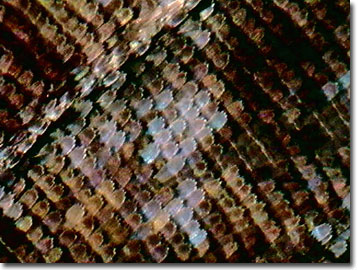Butterfly Wing Scale Digital Image Gallery
Blue Wing Butterfly
Blue wing butterflies glow as if illuminated by a celestial light. Only the Neotropical morpho butterflies surpass the brilliant blue hues of this Amazonian species. These lepidopterans sometimes have the appearance of being four-legged because their short, brush-like front legs often go unnoticed.

The modified pair of legs is a characteristic that places the blue wing butterflies in Nymphalidae, the largest of the butterfly families. Members of Nymphalidae are commonly called brush-footed butterflies because their front legs are covered with long hairs that appear similar to brush bristles. Butterfly species in the family use only their middle and hind legs for walking, display large knobs at the ends of their antennae, and have robust, furry projections called palpi on both sides of their faces, which protect their proboscises.
Scientifically classified as Myscelia orsis, blue wing butterflies exhibit more colors than their name implies. The adults display black markings on the upper sides of their wings and a tan, leaf-like design on the undersides. When at rest, the butterflies hold their wings in a position that exposes their cryptic wing undersides, allowing them to virtually disappear in the tropical forest. The species exhibits sexual dimorphism through over wing coloration. The males are a richer, deeper blue, while the females appear in duller shades and exhibit more strongly striped upper wing patterns. The females display signs of Batesian mimicry, closely resembling the female Catonephele nyctimus, a toxic Amazonian shoemaker butterfly.
Blue wing caterpillars are not as graceful and elegant as the adult butterflies. The caterpillars feature a head capsule topped with two large horns and bodies covered with white tubercles that look similar to warts. Numerous spines are also visible on their posterior body segments. The blue wing caterpillars favor a variety of plants, such as croton, poinsettias, noseburn, and nettleleaf. Amazonian tribes utilize extracts from many of their preferred larval food sources for various pharmacological purposes.
Blue Wing Butterfly Images in Brightfield Illumination
Wing Scale Array - In this high magnification brightfield image the configuration of a blue wing butterfly's wing scales is easily discerned. The tapered shape of individual scales can also be clearly observed.
Blue Wing Butterfly Images in Darkfield Illumination
Wing Scale Interference Patterns - Interference patterns that resemble the stripes of a zebra are displayed on the scales of a blue wing butterfly in this unique darkfield image.
Blue Wing Butterfly Images in Oblique Illumination
Wing Scales and Membrane - On an area of wing that has lost its scales, small spots can be seen where they had been rooted, or imbedded, into the membrane. The pointed end of the specimen's wing scales is difficult to see in this photomicrograph, but was admirably captured in the additional brightfield image.
Contributing Authors
Cynthia D. Kelly, Shannon H. Neaves, Laurence D. Zuckerman, and Michael W. Davidson - National High Magnetic Field Laboratory, 1800 East Paul Dirac Dr., The Florida State University, Tallahassee, Florida, 32310.
BACK TO THE BUTTERFLY WING SCALE IMAGE GALLERY
BACK TO THE DIGITAL IMAGE GALLERIES
Questions or comments? Send us an email.
© 1995-2025 by Michael W. Davidson and The Florida State University. All Rights Reserved. No images, graphics, software, scripts, or applets may be reproduced or used in any manner without permission from the copyright holders. Use of this website means you agree to all of the Legal Terms and Conditions set forth by the owners.
This website is maintained by our
Graphics & Web Programming Team
in collaboration with Optical Microscopy at the
National High Magnetic Field Laboratory.
Last Modification Friday, Nov 13, 2015 at 01:19 PM
Access Count Since January 21, 2003: 34010
Visit the website of our partner in introductory microscopy education:
|
|
